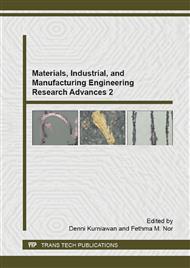p.190
p.195
p.200
p.205
p.210
p.217
p.222
p.227
p.235
Improved Coefficient of Friction Using Different Types of Lubricants in Drilling Operation
Abstract:
The key performance of any drilling operation depends heavily on the choice of drilling fluid used as well as how good it can overcome the drill pipe friction. It is essential that the drilling fluid be able to reduce bit wear, torque and drag. Drilling with oil-based drilling fluid offer less torque and drag. However, water based drilling fluid are cheaper and environmental friendly compared to oil-based and synthetic-based drilling fluids. Lubricants are added to drilling fluid to produce a thin film of liquid that separates the solid surfaces in contact to reduce the friction to an acceptable range. This study focused on the performance evaluation of two different commercial lubricants, which are EBL and EME salt to improve the lubricity of water based drilling fluid. The performances of lubricants were evaluated by ranging the concentrations from 1%, 2% and 3%. Fann Lubricity Tester is used to test the lubricity of these lubricants. The results reveal that the coefficients of friction for all lubricants were reduced after reaching the optimum concentration at the range of 1 - 2%. Some improvements were observed on the rheological properties such as plastic viscosity, yield point and gel strength when the lubricants were added to the drilling fluid. The values satisfy the requirement accepted by the industry. This study also showed that the applicants of EBL lubricant is better than EME salt in term of reducing the coefficient of friction in drilling fluid.
Info:
Periodical:
Pages:
210-214
Citation:
Online since:
October 2015
Keywords:
Price:
Сopyright:
© 2015 Trans Tech Publications Ltd. All Rights Reserved
Share:
Citation:


